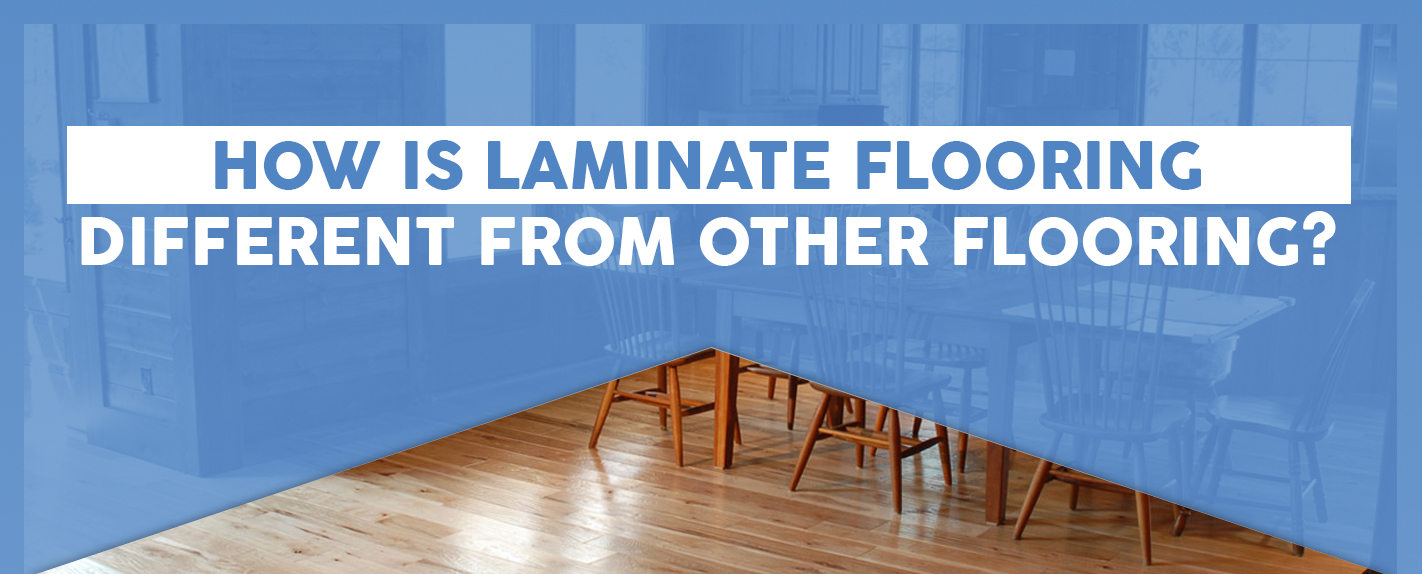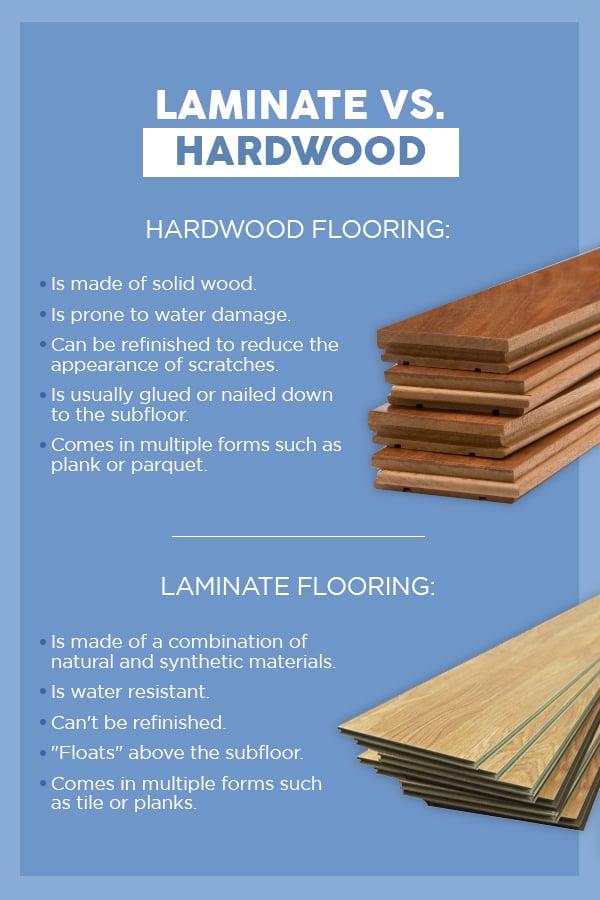 From muddy shoes and wet paws to kids’ toys and high heels, your floors see a lot of action. For that reason, you want flooring that can withstand whatever your family throws its way.
From muddy shoes and wet paws to kids’ toys and high heels, your floors see a lot of action. For that reason, you want flooring that can withstand whatever your family throws its way.
When you’re choosing new floors for your home, you have many options including carpeting, vinyl, hardwood and laminate. Understanding the difference between vinyl and laminate and hardwood can help you choose the hard floor surface that best meets your family’s needs and provides the most comfort and convenience for your home.
What Is Laminate Flooring?
 In many ways, laminate flooring is still a relatively new option. It was invented in 1977 as a way to use a high-pressure laminate material created by the Swedish chemical company Perstorp. Since then, laminate flooring has been popular around the world. In 2018, around 455 million square meters of European-produced laminate flooring were sold around the world. In the U.S., 30.7 million square meters of laminate flooring were sold in 2018.
In many ways, laminate flooring is still a relatively new option. It was invented in 1977 as a way to use a high-pressure laminate material created by the Swedish chemical company Perstorp. Since then, laminate flooring has been popular around the world. In 2018, around 455 million square meters of European-produced laminate flooring were sold around the world. In the U.S., 30.7 million square meters of laminate flooring were sold in 2018.
Laminate flooring consists of several layers of material pressed together. The four layers are meant to improve the durability of the flooring and to help it resist moisture and wear-and-tear. In a typical piece of laminate flooring, you’ll find:
- The backing layer. The backing layer of laminate flooring is typically made of melamine, a durable material that provides structure and support and that also helps the flooring resist moisture.
- The core. The core layer of laminate flooring usually consists of high-density fiberboard, a composite material made from the waste products of wood. In many cases, high-density fiberboard makes up as much as 70 percent of the total weight of a piece of flooring.
- The decorative surface. On top of the core layer is a decorative layer, which makes the laminate resemble a piece of wood board or, in some cases, stone. Typically, the decorative layer is a photo printed on paper.
- The wear layer. The final layer, the wear layer, helps to protect the laminate flooring from wear and tear. Without this top layer, the decorative surface would get scuffed and worn out quickly. Usually, the decorative layer is made from melamine and aluminum oxide. It’s clear so that the photo can show through easily.
Types and Styles of Laminate Flooring
There’s no “one-size-fits-all” option when it comes to laminate flooring. The flooring material comes in a variety of textures and finishes, which makes it a versatile choice for many homeowners. For example, laminate flooring may be sold in square tiles or long planks. The planks might be narrow or wide. It’s also possible to find laminate flooring meant to be installed in a chevron pattern.
The decorative layer of laminate flooring might look like wood or imitate stone. When it comes to the decorative layer, some examples of finish options include:
- Oak finish
- Maple finish
- Cherry finish
- Pine finish
- Stone finish
- Marble finish
- Teak finish
- Mahagony finish
- Walnut finish
- Ipe finish
- Tile finish
In addition to different finishes, laminate flooring can have different textures, depending on the effect you want in your home. Some types of flooring are embossed, meaning they have a texture that makes them look and feel more like natural wood. Other types of laminate flooring have a smooth texture or a glossy, high shine surface.
The Installation of Laminate Flooring
Laminate flooring is a type of “floating floor.” You can install it over a variety of different floor surfaces, from a subfloor to an existing vinyl, tile or hardwood floor. Typically, the only type of existing floor that you don’t want to install laminate on top of is carpet. Carpet is too soft and won’t provide the support laminate needs to stay intact.
During installation, laminate flooring attaches to itself, not to the floor. Although some types of laminate should be glued together, many types join together through tongue and groove joints along the side. One side of a laminate tile or plank has a “tongue,” a protrusion that is usually a bit thinner than the rest of the plank. The other side of the plank has a groove or indentation. The tongue on a plank fits inside of the groove on another plank, firmly attaching the two.
Tongue and groove joinings mean that the planks or tiles of laminate flooring join together without needing to attach to the floor beneath them. Although the attachment is secure, there is still some flexibility, allowing the floorboards to expand and move as needed.
Often, an underlayment will be installed with the laminate flooring. The underlayment rests on top of the existing floor or subfloor. It’s usually made of foam and helps to make the laminate feel softer and more comfortable underfoot. The underlayment also helps to eliminate a “hollow” sound that laminate flooring can produce.
Schedule an Installation Appointment
Caring for Laminate Flooring
Laminate flooring is relatively easy to care for, as long as you keep a few things in mind. First, try to avoid using a lot of water to clean a laminate floor. Although laminate is water resistant, you don’t want to give your floors a soaking with a traditional wet mop and sudsy water. Dousing the floor in water can mean that moisture seeps into the seams between the planks, causing them to swell.
For everyday cleaning of your laminate flooring, all you need to do is sweep the floor to remove any dust and debris. You can use a vacuum on the bare floor setting if you prefer. If anything spills on laminate, it’s a good idea to wipe up and dry the spill as soon as possible.
Once in a while, it can be a good idea to use a damp — not wet — mop or a specialized floor cleaner mop to more deeply clean your flooring.
Some types of cleaners aren’t meant for use on laminate flooring. For example, oil soap can leave streaks on the surface of laminate flooring, and pine-scented cleaners often leave a residue behind. Vinegar-based products can damage the protective coating on the top of laminate flooring.
There are a few things you can do to protect laminate flooring and keep it looking great for years to come. To prevent ice, water, snow and mud from getting tracked into your home and onto your floor, place doormats at the doors of your house. It’s also a good idea to put absorbent mats around any areas where spills are likely. If you have pets, put a placemat under their water bowls. You might want to lay a towel or absorbent pad underneath your baby’s highchair, too.
To protect the surface of the floor, avoid anything that can scratch it. Put protective pads on the legs of chairs and tables so that they don’t scratch the floor. Keep your pets’ claws and nails trimmed so that they don’t dig into the flooring. If you wear high, spiky heels, try to avoid wearing them inside your house for extended lengths of time. It can be a good idea to get in the habit of putting shoes on only when you’re leaving home.
Pros and Cons of Laminate Flooring
Is laminate flooring the right choice for your home? Take a look at some of the pros and cons of laminate flooring to see if it will work for you.
There are many advantages to laminate flooring:
- Relatively easy to care for
- Lots of choices available
- Installs over most existing floors
- Tough and durable
- Can look like “the real thing” when it’s trying to imitate wood or stone
However, laminate flooring does have a few disadvantages:
- Not fully moisture or waterproof and shouldn’t be used in areas of the house prone to moisture, such as high-use bathrooms, kitchens or laundry rooms
- Planks and tiles can’t be refinished and need to be replaced if damaged
- Sometimes has a reputation for being “cheap” or “unattractive,” although recent developments are improving its reputation
- The surface of the floor can feel hard when sitting or walking on it
Luxury Vinyl Flooring Buying Guide
Laminate vs. Vinyl Flooring
 When you’re deciding on new flooring for your home, it can help to fully understand all of your options and how they compare to each other. Laminate flooring is occasionally confused with vinyl flooring, although the two types of floor materials are considerably different. If you are weighing the pros and cons of laminate or vinyl flooring, here’s what you need to know.
When you’re deciding on new flooring for your home, it can help to fully understand all of your options and how they compare to each other. Laminate flooring is occasionally confused with vinyl flooring, although the two types of floor materials are considerably different. If you are weighing the pros and cons of laminate or vinyl flooring, here’s what you need to know.
Schedule Your In-Home Consultation
What Is Vinyl Flooring?
Vinyl flooring is made from synthetic materials, such as polyvinyl chloride (PVC). Like laminate flooring, it consists of multiple layers of material. The core layer provides structure and stability and is often made of fiberglass.
On top of the core layer is the print layer, which has a design or pattern printed on it. Like laminate flooring, vinyl flooring can be printed to resemble stone or wood. Its print layer can also be a pattern, such as an intricate floral design or a checkerboard pattern.
The top layer is the wear layer, which is usually made of polyurethane. The wear layer protects the flooring from scratches, dirt and other damage.
In some cases, vinyl flooring also has a cushioned underlayer made of foam. The underlayer helps to make the vinyl floor more comfortable to walk on and as well as quieter.
Vinyl flooring comes in a variety of formats.
- Vinyl Tiles: Vinyl tiles are typically either 9 inches square or 12 inches square. Vinyl tiles are water resistant and tend to be easier to care for and clean when compared to real tile.
- Luxury vinyl plank:. Vinyl planks might have the most in common with laminate flooring, at least as far as appearance goes. Luxury vinyl planks often imitate the look of natural materials, such as wood or stone. The plank shape of the flooring also helps it to effectively mimic the look of natural materials while still be made from a fully synthetic material.
Vinyl Flooring vs. Laminate Flooring at a Glance
Vinyl flooring:
- Is 100 percent synthetic
- Is best for areas where there’s a lot of water such as bathrooms, laundry rooms and kitchens
- Is easy to clean and care for
- Comes in sheet, tile or plank form
Laminate flooring:
- Contains a mixture of natural and synthetic materials
- Is water resistant, but can be damaged when there’s a lot of moisture, not ideal for high-use bathrooms or laundry rooms
- Is easy to clean
- Can be scratched by high heels, pet’s claws or furniture if pads or protection aren’t used
- Comes in tile or plank form
Laminate vs. Hardwood
 For plenty of homeowners, hardwood floors are the dream. Hardwood is known for its natural look and for creating warmth and an inviting feeling in a home. But if many types of laminate flooring effectively imitate the look and feel of hardwood, is there any reason to go for the real deal? It helps to understand the differences between real wood and laminate and the pros and cons of each.
For plenty of homeowners, hardwood floors are the dream. Hardwood is known for its natural look and for creating warmth and an inviting feeling in a home. But if many types of laminate flooring effectively imitate the look and feel of hardwood, is there any reason to go for the real deal? It helps to understand the differences between real wood and laminate and the pros and cons of each.
What Is Hardwood Flooring?
Hardwood flooring is made from natural wood, specifically wood species classified as “hard.” Hardwood species grow more slowly and produce a denser material compared to softwood species. The density of hardwoods helps to make flooring made from them more durable than other options. A few examples of hardwood species often used to make floors include:
- Birch
- Brazilian Cherry
- Cherry
- Maple
- Oak
- Walnut
Hardwood flooring comes in a variety of shapes, such as planks, thinner strips and parquet. The wood can be stained and finished to suit a homeowner’s tastes.
While hardwood flooring might not be as damage or water resistant as laminate or vinyl flooring, it can still be relatively easy to clean. You can sweep or vacuum hardwood floors to remove dust and debris. If you want to clean the floors more deeply, your best bet is to use a floor cleaner specifically designed for hardwood.
If part of a hardwood floor becomes damaged, it’s possible to sand that portion down and refinish it to make it look good as new. In the case of laminate flooring, you typically need to replace the entire plank or tile if part of it is damaged.
Laminate Flooring vs. Hardwood at a Glance
Hardwood flooring:
- Is made of solid wood
- Is prone to water damage and shouldn’t be used in areas where exposure to moisture or water is likely, such as bathrooms and kitchens
- Can be refinished to reduce the appearance of scratches and dents or to make the floor look like new again
- Is usually glued or nailed down to the subfloor
- Comes in multiple forms such as plank or parquet
Laminate flooring:
- Is made of a combination of natural and synthetic materials
- Is water resistant
- Can’t be refinished and needs to be replaced if significantly damaged
- “Floats” above the subfloor
- Comes in multiple forms such as tile or planks
Find Flooring Solutions at 50Floor
 Is laminate flooring the right choice for you or would you rather have vinyl or hardwood? 50Floor can help you decide. As part of our shop at home experience, an expert from our team will bring floor samples right to your house and help you choose the material that works best with your house’s natural lighting and design as well as your family’s lifestyle. To learn more, schedule an appointment with 50Floor today.
Is laminate flooring the right choice for you or would you rather have vinyl or hardwood? 50Floor can help you decide. As part of our shop at home experience, an expert from our team will bring floor samples right to your house and help you choose the material that works best with your house’s natural lighting and design as well as your family’s lifestyle. To learn more, schedule an appointment with 50Floor today.





